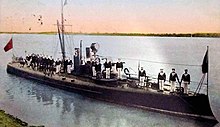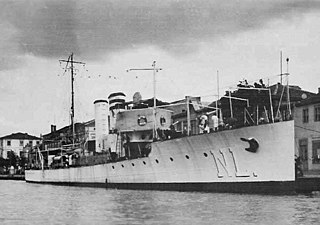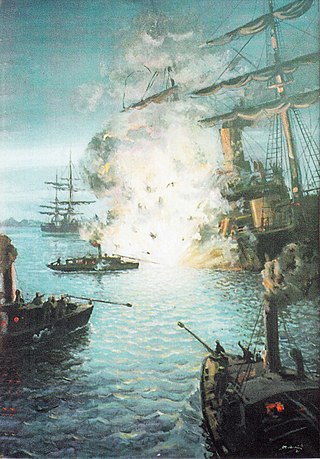Pre-World War I expansion
| The Romanian Danube Flotilla in the early 1910s | |
| Number of units | |
| River monitors | 4 |
| Torpedo boats | 15 |
| Gunboats | 10 |
| Minelayers | 1 |
1882

The first expansion of the Romanian Danube Flotilla took place in 1882. Two armored torpedo boats, Șoimul and Vulturul, were purchased from Yarrow in Britain, where Rândunica was also built seven years prior. These boats had a displacement of 12 tons, measuring 19 meters in length, with a beam of 2.5 meters and a draught of 1 meter. Power plant consisted of one 150 hp steam engine generating a top speed of 16.5 knots. Each boat had a crew of 8 and was armed with a single spar torpedo. Aside from increased dimensions and greater speed, the two boats were also fitted with bulletproof armour. [3] [4] These two boats were followed by three Rahova-class gunboats, also built in Britain at Thames Iron Works. With a displacement of 45 tons and a top speed of 8.5 knots, these small gunboats were each armed with one 37 mm gun and one machine gun. Also commissioned in 1882 was the 104-ton guard ship Alexandru cel Bun. [5] The latter was used as a minelayer during the First World War. She measured 23 meters in length, with a beam of 4.6 meters and a draught of 1.5 meters. She was powered by 100 hp steam machinery, giving her a top speed of 9 knots, and could carry 12 tons of coal. Her crew amounted to 20 and her armament consisted of two 37 mm guns and two machine guns. [6]
1888

The second expansion of the Flotilla took place in 1888, when three 116-ton Oltul-class gunboats were commissioned. These vessels measured 30.5 meters in length, with a beam of 4.1 meters and a draught of 1.7 meters. They were also built by Thames Iron Works and each was armed with one 57 mm gun and one 37 mm gun. Crewed by 30 men each, they had a top speed of 13 knots generated by 380 hp steam propulsion, carrying a maximum of 12 tons of coal. [7]
1893-1894
Two consecutive expansions followed in the 1890s. In 1893, three 95-ton guard ships of unknown origin were commissioned. Each was armed with one 57 mm gun and two 37 mm guns, having a top speed of 13.5 knots. [8] A further expansion followed in 1894, when four German-made torpedo boats were commissioned. Known as the Vedea -class, they were built at Schichau-Werke, having a displacement of 30 tons, measuring 20 meters in length, with a beam of 3 meters and a draught of 1.5 meters. Each boat had a crew of 16 and a top speed of 10 knots. Armament consisted of one 37 mm Hotchkiss revolving gun, one machine gun and two spar torpedoes. [9] [10]
1906-1908

This was by far the greatest pre-war expansion of the Romanian Danube Flotilla. Between 1906 and 1907, a class of 8 British-built torpedo boats was commissioned. These 50-ton vessels, built by Thames Iron Works, were well-armed for their size: in addition to one 47 mm naval gun and one 6.5 mm machine gun, each boat also carried 4 torpedoes: two on spars in front of the vessel and two more amidships in torpedo dropping gear (carriages). They measured 30 meters in length, with a beam of 4 meters and a draught of less than 1 meter. These boats were also armored, having bulletproof sides and deck. They were powered by two compound engines powering two shafts, resulting in an output of 550 hp and a top speed of 18 knots. They could carry up to 7.6 tons of oil and had a crew of up to 20. [11] Between 1907 and 1908, four large river monitors were commissioned. They were built in sections at STT in Austria-Hungary. Their sections were then transported to the Galați shipyard in Romania, where they were assembled and launched. Standard displacement amounted to 680 tons, increasing to 750 tons at full load. Each monitor measured 63.5 meters in length, with a beam of 10.3 meters and a draught of 1.6 meters. Power plant consisted of two engines and two Yarrow boilers powering two shafts, generating a total of 1,800 hp which resulted in a top speed of 13 knots. The monitors had a crew of 110 and a range of 1,500 nautical miles at a speed of 9.7 knots. Armor thickness reached 70–75 mm on the belt, deck, turrets and conning tower. Armament during World War I consisted of three 120 mm Škoda naval guns in independent armored turrets, one 120 mm Škoda naval howitzer, four 47 mm Škoda naval guns and two 6.5 mm Romanian-made Maxim machine guns. [12] [13]




















